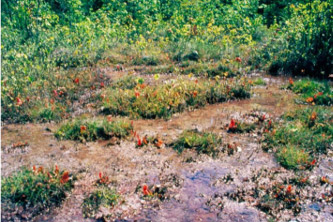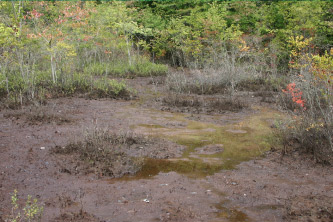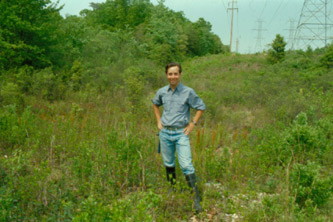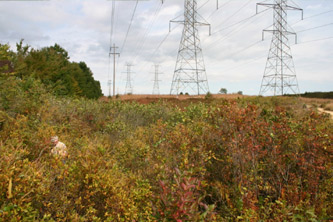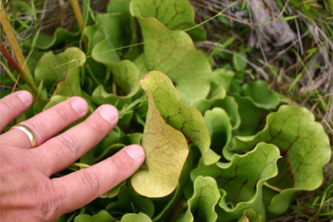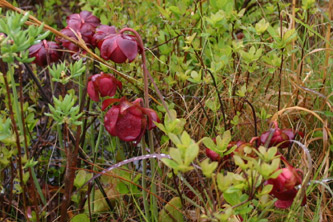Letter from the President - Pitchers in Peril!
This is the Holiday Season for giving and I am personally investing in the future of Meadowview by donating my major asset: the house and grounds where Meadowview is located in Caroline County, Vir-ginia (see front page story). I worked very hard to pay off this property within 15 years while working in the banking industry (at low wages) and attending school to obtain my bachelors and masters degrees in bi-ology. This donation is possible because I was blessed to meet and marry a wonderful woman who is equally supportive of the Meadowview work in preventing the extinction of the pitcher plants and their eco-system.
I am donating this property to establish the headquarters of Meadowview and start our first preserve in Caroline County. Meadowview needs a matching donation to acquire a 3 acre pine woods and sphagnum bog contiguous to the research station. My wife purchased this 3 acre property in 2002 but she is not in a position to donate this asset. Since I am a board member, and this property is also in my name, Meadow-view has been extremely careful to avoid any conflict of interest in this land purchase and the following steps were taken: I was not able to vote on the decision to purchase the property; an independent appraisal of the property was performed by a certified appraiser; the value of the land as a buildable lot was substanti-ated by county certification of drain field, house, and well site. Meadowview has no intention of building on this property.
I am donating my house and land as leverage for Meadowview to purchase this three acre tract and start our Caroline County preserve. The situation is urgent since we are losing our native pitcher plant populations in Maryland and Virginia and facing the extinction of these amazing plants. I’m defending my Ph.D. dissertation at Old Dominion University in Norfolk, Virginia and I would like to share with you some of my results documenting the extirpation of these plants. During my tenure in the Ph.D. program we have lost almost half our native purple pitcher plant colonies, and the remaining populations are almost all in serious decline. The population declines and extinctions are largely due to un-checked succession and beaver flooding.
Unless we act now by purchasing land to preserve pitcher plant populations, we are facing extinction of these plants in our region. This crisis is highlighted by the fact that pitcher plants are being lost on state preserves with prescribed burns such as the Zuni Pine Barrens in Virginia or the natural gaps at Arden Bog in Maryland.
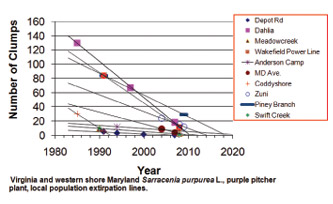
The loss of almost the entire Arden pitcher plant population is particularly tragic and stresses the need for the mission and role of Meadowview. Arden bog con-tained over 1000 native state threatened purple pitcher plants and was the largest S.purpurea population on the western shore of Maryland and Virginia. The site is also a state natural area specifically purchased because of the pitcher plants and rare associates. Meadowview biologists noticed beaver activity and rising water levels in August 2007 and alerted Maryland Natural Heritage botanists who checked the site in Dec. 2007. They reported no beaver activ-ity despite the fact that local environmentalists were witness-ing flooding of the bog. Measures to control the beaver and reduce water levels were not taken until July 2008 by which time almost all the pitcher plants were dead (9 plants were found in 2009). Pitcher plant seed was harvested from the Arden bog by Arlington Echo Outdoor Education Center in Millersville, Maryland and propagated for educational work. However, once the plants reached maturity Maryland Natural Heritage staff instructed them to throw the plants away! Fortunately, Arlington Echo shared this valuable germ-plasm with Meadowview in 2008 and we have a significant portion of this genetic material in ex-situ conservation. However, this is no substitute for properly safeguarding natural pitcher plant populations. If the largest native purple pitcher plant population in our region cannot be adequately protected on state land how can we expect these plants to survive on other non-protected sites? We need your help!
The case of Piney Branch bog in Maryland illustrates the powerful impact of succession in eliminat-ing pitcher plants and rare plant associates from habitat. When we originally found the site it was an open powerline right-of-way with a flourish-ing population of 84 S. purpurea and a number of state rare plant species. The Nature Conservancy received a $500,000 award in 2001 to manage the bog and finally in 2009 started to clear the site, which by then had dwindled to 31 spindly pitcher plants. If the Nature Conservancy had not intervened in such a timely manner we would have almost certainly lost this pitcher plant popu-lation.
In other cases, succession is eliminating pitcher plants from historical sites where they have persisted for decades. Meadowview redis-covered M.L. Fernald’s Coddyshore bog in 1985 and found 30 pitcher plants. The entire popula-tion was extirpated by 2007 because of succession and changing land use practices.
The following graph shows how all of these factors (succession, beaver flooding, mismanagement, etc.) are leading to extinction of our native pitcher plant populations. The predicted extirpation date (2055) for S. purpurea in Virginia is extremely conservative and does not account for the acceleration caused by the current extinction vortex. Therefore, S. purpurea extirpation in Virginia could occur as soon as 2030.
These examples show a great need for Meadowview and its mission to preserve, protect, and restore the native pitcher plant popu-lations and their associated ecosystems in Maryland and Virginia. The question then becomes: What have we done and what are we go-ing to do to prevent this extinction crisis?
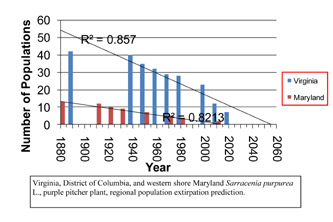 First, we continue to obtain propagules from dwindling pitcher plant populations for ex-situ conservation. This effort has already pre-vented the loss of all Virginia S. flava populations and most, but not all, purple pitcher plant populations in Virginia and Maryland. Sec-ond, we work with landowners that have native pitcher plant popula-tions and educate them to the value of their plants and prescribe ap-propriate site management. Third, we are aggressively pursuing our long term plan of owning a series of managed pitcher plant bog pre-serves. From the few examples shown, it is clear that without site. control most of our native pitcher plant populations will become extinct. Meadow-view has been successful in re-establishing a number of southern Virginia pitcher plant populations in discrete bogs on the Joseph Pines Preserve with flowering, seed set, and successful regeneration. This work has been done within the context of restoring authentic plant com-munities utilizing local, and in most cases rare, genotypes. We need more land at the preserve to accommo-date additional populations and we separate preserves to maintain the identity of the central Virginia and Maryland pitcher plant genotypes. Fourth, we are laying the groundwork to endow Meadowview with the financial wherewithal to sustain this effort long-term. We are training the next generation and are recruiting senior talent to manage our organization. Please join me in achieving the noble goal of preventing extinc-tion of the pitcher plant community and associated ecosystems. Imagine the thrill of future generations when they see, study, smell, and wander through the woods and bogs of large-scale restored pitcher plant ecosystems.
First, we continue to obtain propagules from dwindling pitcher plant populations for ex-situ conservation. This effort has already pre-vented the loss of all Virginia S. flava populations and most, but not all, purple pitcher plant populations in Virginia and Maryland. Sec-ond, we work with landowners that have native pitcher plant popula-tions and educate them to the value of their plants and prescribe ap-propriate site management. Third, we are aggressively pursuing our long term plan of owning a series of managed pitcher plant bog pre-serves. From the few examples shown, it is clear that without site. control most of our native pitcher plant populations will become extinct. Meadow-view has been successful in re-establishing a number of southern Virginia pitcher plant populations in discrete bogs on the Joseph Pines Preserve with flowering, seed set, and successful regeneration. This work has been done within the context of restoring authentic plant com-munities utilizing local, and in most cases rare, genotypes. We need more land at the preserve to accommo-date additional populations and we separate preserves to maintain the identity of the central Virginia and Maryland pitcher plant genotypes. Fourth, we are laying the groundwork to endow Meadowview with the financial wherewithal to sustain this effort long-term. We are training the next generation and are recruiting senior talent to manage our organization. Please join me in achieving the noble goal of preventing extinc-tion of the pitcher plant community and associated ecosystems. Imagine the thrill of future generations when they see, study, smell, and wander through the woods and bogs of large-scale restored pitcher plant ecosystems.
Sincerely,
Phil Sheridan
Director and President
“Indeed, it has been quite a pleasure to have experienced and studied these [bogs and cedar swamps] ecologically significant sites. Local and State governments should immediately institute a truly effective effort, perhaps acquisition, including appropriate buffer areas, to preserve their natural integrity. Indeed, I am convinced that society should demand it.”
-
Bill Sipple, Days Afield. 1999. Gateway Press, Inc.





